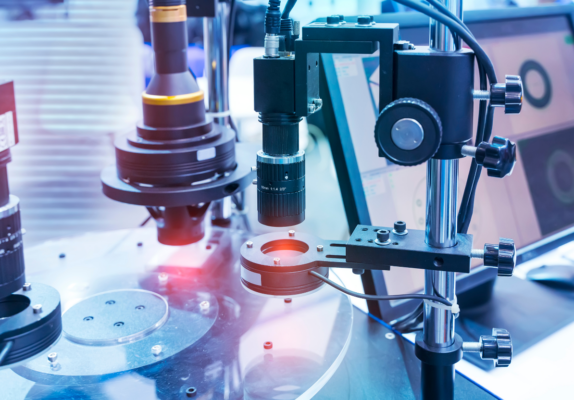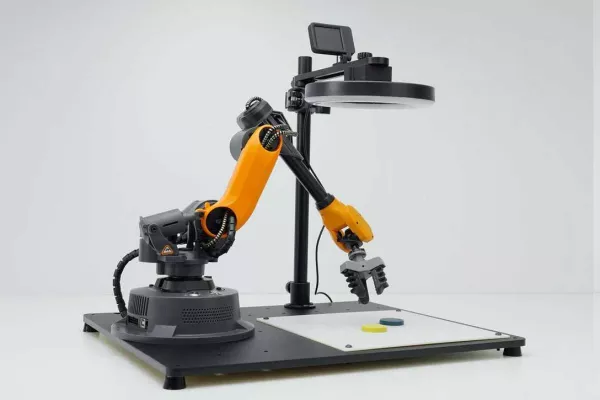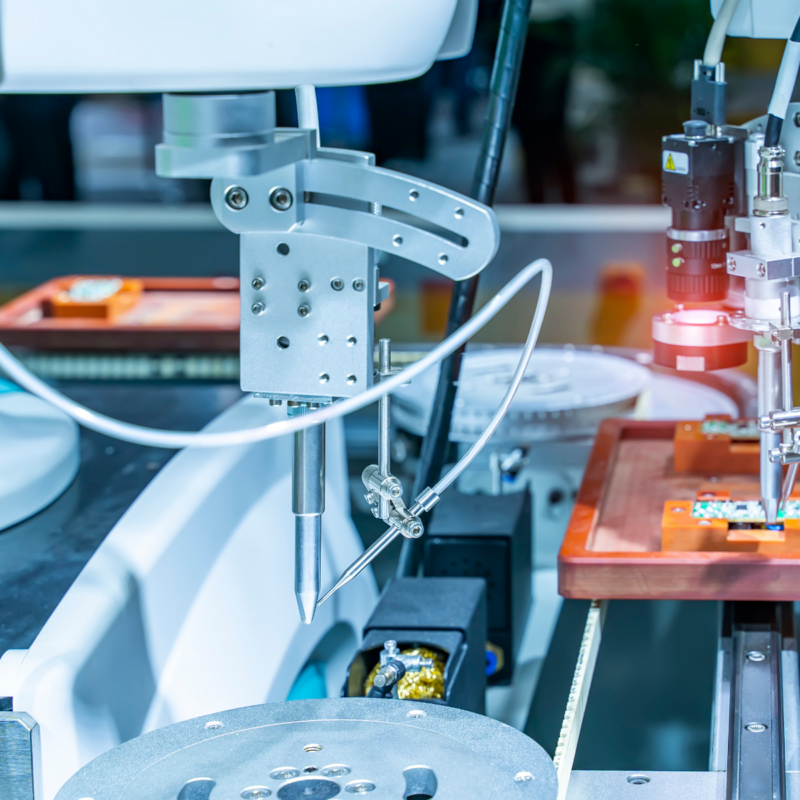In 2025’s fast-moving manufacturing world, having the best tech means staying ahead. This means using the top 2D vision systems will boost your line’s precision and speed. These systems are game-changers, making your operations smarter and more flexible. As you think about upgrading, we’ve got the scoop on the top 5 2D vision systems of 2025. Each one brings something special to the table, from smart AI capabilities to unmatched adaptability.
Ready to take your manufacturing line to the next level?
Let’s explore these standout options and find the perfect match for you.
What is a 2D Vision System?
A 2D vision system is like the eyes of your manufacturing line, giving machines the power to see and understand what’s around them. Imagine your robot or industrial machine being able to spot, identify, and measure parts with just a glance. That’s what these systems do. They use cameras and special software to capture images in two dimensions (that’s the “2D” part). Then, they analyze these images to make decisions, like where to place an item or whether a part passes quality control.
These systems are a big deal because they make your operations faster, more accurate, and less prone to errors. Whether you’re sorting products, checking for defects, or assembling parts, a 2D vision system helps you do it more efficiently.
In short, integrating a 2D vision system into your line means upgrading to smarter, smoother operations. It’s all about giving your machines the gift of sight, so they can work better for you.

How does a 2D Vision System Work?
A 2D vision system works by taking a photo of your product and analyzing it against the standards you’ve set. Here’s how it works:
- Capturing the Image: A camera snaps a clear picture of your product.
- Analyzing Details: The system’s software looks at the image, checking things like shape, size, color, and placement.
- Spotting Issues: It compares the product to your requirements, spotting flaws or confirming it meets quality standards.
- Taking Action: Based on what it finds, the system either rejects defective items or guides your robot to handle the product correctly.
It’s fast, accurate, and keeps your production line running smoothly while ensuring top-quality results.
Top 5 2D Vision System of 2025:
1. COGNEX In-Sight SnAPP Vision Sensor & COGNEX 8100:
When it comes to enhancing your manufacturing line, the COGNEX US In-Sight SnAPP Vision Sensor and COGNEX 8100 are standout choices. Let’s break down what each of these powerful tools can do for you.
COGNEX US In-Sight SnAPP Vision Sensor is your go-to for a smart, adaptable vision system. It’s all about making your life easier with its AI-driven capabilities. This compact device packs a punch with a 1.6 MP image sensor that sharpens image quality, alongside autofocus options that adjust to your needs on the fly. Plus, its IP67 rating means it’s tough enough to handle dusty and wet conditions without a hitch. Ideal for a variety of applications, from precision assembly to quality inspection, it’s designed to slot into your line seamlessly. Want more info?
Check out their website to dive deeper.
Moving on to the COGNEX 8100, it’s the definition of high-performance in a small package. With a 0.31 MP between 5.01 MP resolution and a rapid 32 FPS to 217 FPS frame rate, it’s built for speed and precision. Whether you’re in automotive, aerospace, or any sector needing top inspection, this system has you covered. Its dual color and monochrome capabilities ensure versatility across different tasks. And with a solid 4.0 out of 4 reviews, users are loving it.
If your industry demands quick, accurate visual inspection, these COGNEX solutions are worth a closer look.
2. Micropsi Industries MIRAI AI Vision System:
MIRAI is all about precision and adaptability. It uses AI to guide robots, allowing them to handle tasks with the kind of flexibility that was once unthinkable. From dealing with unpredictable scenarios to adjusting on the fly, MIRAI makes it easy. This means less downtime for you and a significant boost in productivity.
What sets MIRAI apart? It’s the way it seamlessly trains on-site for new tasks. You won’t be stuck with a system that can only do what it was initially programmed for. MIRAI evolves, learning to tackle new challenges as they come. This makes it a perfect match for any task you throw at it, whether it’s sorting, assembling, or something entirely new.
And the best part? Getting started with MIRAI is straightforward. Its intuitive setup means you can bring this advanced AI capability to your line without a steep learning curve. This is about making your workflow more efficient and your life easier.
Curious to see MIRAI in action? Try it out with a free demo!
3. Specim FX-series:
Starting with the Specim FX10, it’s a powerhouse designed for versatility and precision. This camera specializes in VNIR (visible and near-infrared) imaging, making it your go-to for capturing detailed images and measuring colors with accuracy. Its compact size doesn’t compromise on speed; with a frame rate of 327FPS, you won’t miss a beat, whether you’re on the manufacturing floor or in the lab. The FX10 offers both color and hyperspectral imaging capabilities, ensuring you get comprehensive data from every shot.
Expanding the series, the FX17 and FX50 bring their unique strengths to the table. The FX17 continues the trend of exceptional near-infrared performance, perfect for applications needing deeper insight beyond the visible spectrum. Meanwhile, the FX50 steps it up with MWIR (mid-wavelength infrared) imaging, opening the door to applications requiring thermal imaging or specific material identification.
What does this mean for you? Whether you’re inspecting products for quality control, conducting advanced research, or needing precise color measurements, the Specim FX-series has a solution tailored to your needs. Their fast, flexible, and detailed imaging capabilities make them invaluable tools in both industrial and scientific settings.
4. WLKATA Robotics AI Vision Set:
At the core of WLKATA’s AI Vision Set, this set is about bringing AI learning to your fingertips. Imagine giving your robot the ability to see, recognize, and respond to objects with incredible accuracy. That’s exactly what you get with this AI Vision Set. It’s designed to be user-friendly, making it accessible whether you’re a seasoned engineer or a student diving into robotics for the first time.
The set’s modular design means it’s flexible and adaptable to a wide range of projects. You’re not just buying a piece of equipment; you’re investing in a versatile tool that grows with your needs. And with Python programming support, you have the freedom to customize and expand its capabilities even further.
But that’s not all. The AI Vision Set comes with a comprehensive textbook, guiding you through various applications and teaching you how to leverage AI in robotics. This educational component is invaluable, providing you with the knowledge and skills to push your projects to new heights.

5. KEYENCE Vision Sensor – IV Series:
The KEYENCE IV Series is all about versatility and precision. Whether you need to work with color or monochrome images, the IV Series has got you covered. With a frame rate of 60FPS, it quickly processes images, ensuring your line keeps moving without sacrificing quality. It’s like having a vigilant quality controller that works tirelessly, ensuring every product meets your high standards.
What sets the IV Series apart is its built-in AI. This isn’t just any vision sensor; it’s a smart solution that learns and adapts to your specific needs. It can distinguish between complex patterns and subtle color differences, making it perfect for a wide range of applications. From automotive parts to food packaging, this sensor ensures that only the best products make it through your line.
The ease of integration is a game-changer. You won’t need to spend days setting it up. KEYENCE designed this sensor to be user-friendly, allowing you to integrate it into your existing setup smoothly and start reaping the benefits right away.
Choosing the Right 2D Vision System: What to Consider
When searching for the right 2D vision system to improve your manufacturing process, navigating the vast amount of options can be daunting. Let’s break it down into bite-sized pieces to ensure you make a choice that truly aligns with your needs.
Understand Your Needs
First off, pinpoint exactly what you need the system for. Is it for spotting defects, guiding machinery, or maybe for sorting products? Different systems shine in different areas. For high-speed operations, you’ll want something quick. For precision tasks, look for a system with great accuracy. Knowing your primary need will narrow down your options.
Check Compatibility
Your new vision system must fit perfectly into your existing setup. Ensure it can easily integrate with your current machines and software. This compatibility saves you from unnecessary stress and ensures a smooth operation.
Ease of Use & Support
A system that’s tough to install or maintain can become a burden. Look for one that’s user-friendly from the get-go. Good customer support is also crucial. It ensures you get help quickly whenever you run into issues.
Consider Your Budget
More expensive doesn’t always mean better for your specific needs. Sometimes, a simpler and more budget-friendly option does the job just as well. Don’t let a high price tag sway you if a more affordable system meets your requirements.
By focusing on these key areas, you’ll be well on your way to selecting a 2D vision system that fits your manufacturing line perfectly.
Conclusion:
To sum up, picking the best 2D vision system for your line means knowing what you need, making sure it fits with your gear, finding something easy to use, and keeping within your budget. Look for what matches your main goal—speed, accuracy, or flexibility. Take your time to compare and decide. Your aim is to improve how your line works and the quality of what it makes. Ready to upgrade?
Do You Want to Compare Different 2D Vision Systems?






